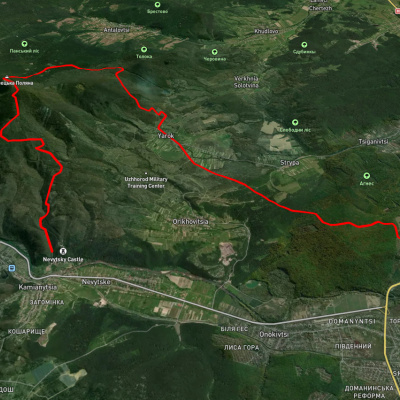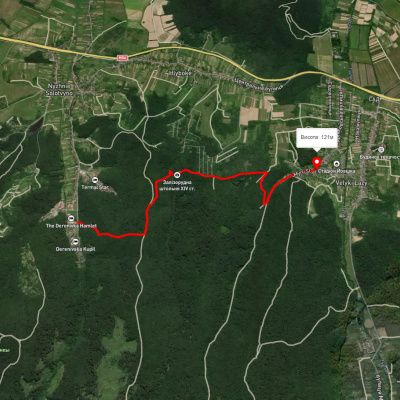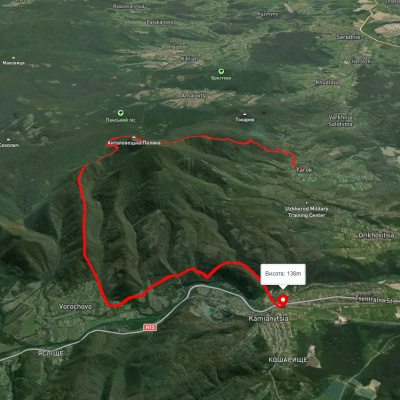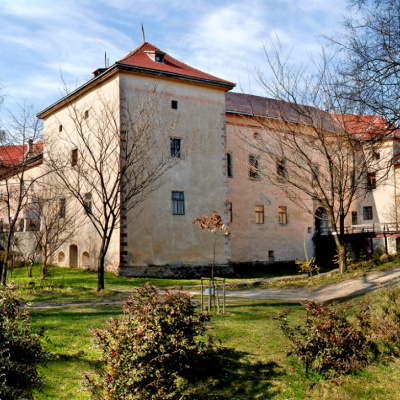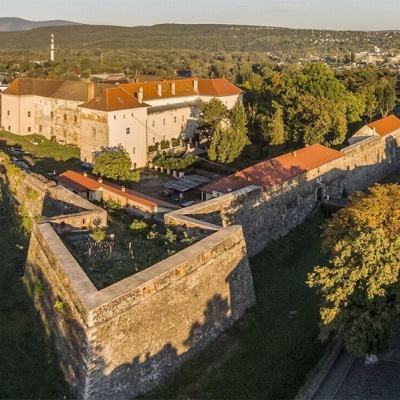Uzhhorod
Uzhhorod (Hungarian: Ungvár, Slovak: Užhorod; Ungvar - until January 1919, November 9, 1938 - October 1944) is a city on the Uzh River, the administrative center of the Zakarpattia region and Uzhhorod district. It is located 785 km from Kyiv, on the border with Slovakia.
The city at the foot of the Carpathians is the smallest regional center in the country, but it has a rich and ancient history. Founded in the XI century, it became a fortress of the Druget family, and later came under the rule of Hungary and Austria-Hungary. Uzhhorod developed as an industrial and cultural center of Zakarpattia. In 1919, it was the capital of Subcarpathian Rus as part of Czechoslovakia, and in 1945 it was transferred to the Ukrainian SSR.
The heart of the city is its Uzhhorod Castle; numerous tourists are also attracted to the church, synagogue, and bishop's residence. In 1646, under the auspices of the Vatican, the Union of Uzhhorod was proclaimed and the Greek Catholic Church in Zakarpattia was established.
Al-Idrisi's report in 1154 is the oldest written source that mentions Uzhhorod. According to historical documents, the city had only one name from the time of its first mention until the end of World War I: Ungvar (modifications of Gunkbar, Gungvar, Ongvar). In the mid-nineteenth century, the name Uzhhorod finally appeared. It emerged under the influence of the rise of national movements of the Ruthenian population of the region, especially during the Hungarian Revolution of 1848-1849. The new name of the city, Uzhhorod, did not catch on at the time. It was remembered only after the First World War, when Transcarpathia was annexed by Czechoslovakia and the new government decided to Slavicize the names of the cities and villages of the region. Since then, with the exception of a short period (1938-1944) when Zakarpattia was part of Hungary, the name Uzhhorod has been officially used.
The coat of arms of Uzhhorod is the official emblem of the city, approved by the Uzhhorod City Council on June 14, 1990. It is a German shield on a blue field depicting three golden vines growing out of the ground, crossing each other, with three leaves and two bunches of grapes on them. The vine in the symbolism of the city has been known since 1635, when the city used a seal with a picture of a vine bush with three vines and two bunches. The coat of arms on the seal framed the inscription: "Sigillum civitatis Ungvariensis". The color image of the Uzhhorod coat of arms has been known since 1701. On December 12, 1905, the Hungarian Ministry of the Interior sent an official description of the coat of arms to Uzhhorod in a letter: "A shield in the Baroque style, blue, on which a grape bush with three vines grows from the green ground, of which the extreme ones in the middle of the shield cross each other and one bunch hangs from them, and one green leaf hangs from each of the three vines." In 1913, the coat of arms was depicted on the building of the city hospital, where vines and grape leaves were cast in gold. This color scheme is considered "authentic," that is, one that corresponds to the original appearance of the coat of arms.
There are many parks and squares in Uzhhorod, including a botanical garden (of national importance), 10 parks-monuments of landscape art, as well as two botanical natural monuments and two hydrological natural monuments:
- Uzhhorod Botanical Garden;
- Bozdosh Park, Linden Alley, Regional Hospital Front Garden, University Library Front Garden, State University Chemical Building Front Garden, Parterre Square, Pidzamkovy Park, Rockery of the Zakarpatlis CJSC, City Hospital Square, T. Masaryk Square;
- Cypress marsh, Masaryk ash;
- Source No. 1, Well No. 221;
- Due to the mild winters, a giant sequoia tree, about 100 years old, grows in the Uzhhorod Botanical Garden.
The remains of settlements have been discovered on the territory of Uzhhorod, the oldest of which date back over a hundred thousand years. Over the centuries, many tribes and peoples have passed through the territory of the modern city: Huns, Avars, Burgundians, Dacians, Celts, and Sarmatians. One of the first known founders of the Uzhhorod settlement were white Croats who settled the territory of modern Uzhhorod in the second half of the 1st millennium. The settlement was called Ongvar (or Ungvar, or Gungvar, or Ungyuvar). Over the centuries, three city centers have historically developed: Horyany, Castle Hill, and Radvanka. Horyany is a village that is now part of the city of Uzhhorod.
In the ninth century, a more fortified castle settlement on Castle Hill turned into an early feudal town-settlement, which became the center of the newly formed Slavic principality headed by Prince Laborets. To the west, the Laborets' principality bordered on the Great Moravian principality, and to the south on the First Bulgarian Kingdom. It is possible that the Uzhhorod settlement was at some time a part of them. In 894, Hungarian tribes under the leadership of the sacred leader Almosh and the military leader Arpad stormed the city's fortress, which was defended by Prince Laborets and his soldiers, for four days. However, the forces were unequal, and the prince and his army were killed. The settlement itself was burned down, but after a while it was rebuilt by the new owners. After the arrival of the Hungarians, the town began to develop and expand around the castle. In 1086, Uzhhorod was attacked by the Polovtsians of Khan Kutesk, but they failed to take it.
In 1241-1242, the Tatar-Mongol tribes under the leadership of Batu Khan burned the city. The new city (Unguyvar) - New Uzhhorod - was built on a new site in the modern Horyany neighborhood in 1248 by order of the Hungarian king Bela IV. A new fortress and a church(Horyany Rotunda) were also built here. In 1290, Omodey Aba, the chancellor of the Kingdom of Hungary, became the new owner of the city. During the feudal internecine wars in the early fourteenth century, Uzhhorod suffered significant destruction. In 1312, the new owner of the fortress city was Petro Pete, who in 1315 raised a rebellion against the king, which was suppressed two years later.
In 1318, the city received new owners, the Italian counts of Druget, who owned it for 360 years. Philip Druget built a new stone fortress on the site of the modern Uzhhorod Castle. The history of the medieval castle itself dates back more than a thousand years. Over the centuries, the castle was repeatedly rebuilt in accordance with the requirements of medieval fortification. To this day, only a part of the foundation has survived from its oldest structures, traces of which can be seen in the dungeons, as well as fragments of cornices with Romanesque ornaments. The main building dates back to the XIV century. In the late X - early XI century, when the plain part of Transcarpathia fell under the rule of the Kingdom of Hungary, a stone castle was built in Uzhhorod as the administrative center of the Ung comitatus. It was already a powerful defensive structure, the strength of which is evidenced by the fact that in 1086, during the raid of the Polovtsian horde led by Khan Kutesk, which broke through the Carpathian passes to the Danube lowlands, the nomads failed to take Uzhhorod Castle.
During the period when the castle was in the possession of the Druget family (1322-1691), great changes took place in the art of fortification, caused mainly by the emergence of new types of weapons, especially firearms. All of this required a radical reconstruction of the castle, which was carried out in the late sixteenth century using the latest achievements of European fortification art. Uzhhorod Castle was reconstructed according to the project of Italian engineers in order to strengthen its defense capabilities: stronger walls were built at a certain distance from the palace, a diamond-shaped bastion was built at each corner, extended beyond the line of the square of the walls, which we can still see today, which greatly enhanced the effectiveness of the castle defense with the help of artillery installed on the bastion sites. Above the entrance to the castle palace, four blackbirds, the Druget family coat of arms, are carved in bas-relief on a stone slab.
The castle has the shape of an irregular quadrangle with a bastion at each corner. The bastions protrude slightly forward, which made it possible to successfully conduct a flanking battle. The bastions, which are 10-15 meters high, housed cannons that kept the approaches to the castle under fire. To strengthen the strength of the bastions, their horns were lined with white stone squares. The castle seems almost impregnable. Its impregnability is especially emphasized on the north side by a massive row of high walls, devoid of even loopholes. The walls are built mostly of stone. The northern part of the castle was protected by a keel-shaped bastion. A deep moat (8-10 m) surrounds the castle on three sides, over which a drawbridge was thrown. To this day, there are still the chains for the chains that were used to raise the bridge.
In 1775, the castle was transferred by Empress Maria Theresa to the Mukachevo diocese. During this period, the castle was undergoing a minor reconstruction, which resulted in the destruction of the knight's hall. Today the castle houses a museum of local lore. The city was developing along with the castle. In 1384, the construction of a new castle was completed, and the first school in the city was opened. In 1430, Uzhhorod received privileges from the king and was officially written as the "Privileged City of Uzhhorod."
In 1514, during a major uprising led by György Dozha, the city was completely destroyed. After the defeat of the Hungarians in the battle with the Turks in 1526 near Mogacs, the Hungarian kingdom was divided into three parts, one of which was the Principality of Transylvania, the second was central Hungary under the rule of the Turks, and the third was western and northern Hungary under the rule of the Austrian Habsburgs. For a long time, the city of Uzhhorod became an arena of internecine battles. In 1538 Uzhhorod was ceded to Transylvania, and in 1540 it was captured by Austrian troops. In 1564, the city was again attacked by Transylvanian troops.
The new owners, the Counts Drugeti, strengthened the city's role as an economic and commercial center. At this time the castle was being rebuilt and new churches were being built. The seal with the inscription "Seal of the city of Uzhhorod. 1675," which depicts the city's coat of arms: a shield with two vines, three leaves, and two bunches of grapes on them, indicating the main occupation of its inhabitants. This coat of arms existed almost unchanged until 1918 (only the color of the shield background changed: in the seventeenth and eighteenth centuries the shield was blue, in the nineteenth century it was red; in the early twentieth century the older version with a blue shield was restored).
In 1631, the city had 10 streets, 206 serfs' yards, 32 noble estates, and a total population of 1200 people. During the XVI-XVII centuries, Uzhhorod had many craft workshops: shoemaking, pottery, carpentry, and cooperage. During this period, the city was involved in a religious struggle between Reformed Transylvania and Catholic Austria. In 1610 the city was dominated by the Catholic Church. In 1619, Uzhhorod was again captured by Protestant troops of Transylvania. After a decade of Reformed rule, Catholics led by Count Druget returned to the city. It was in 1646 that 63 Orthodox priests gathered in the Uzhhorod Castle and under the auspices of the Vatican proclaimed the Uzhhorod Union and formed the Greek Catholic Church in Transcarpathia.
In November-December 1648, during the National Liberation War, Bohdan Khmelnytsky's Cossacks raided the Carpathians beyond the Polish-Lithuanian Commonwealth into Ukrainian Transcarpathia, which was under the control of Transylvania, and for a time took the outskirts of Uzhhorod.
In 1707, Uzhhorod was the residence of Ferenc II Rákóczi, the leader of the Hungarian national liberation war. In general, eighteenth-century Uzhhorod was famous for its fairs.
Merchants from Slovakia, Germany, Hungary, Moldova, Poland, Greece, and Russia came here. At that time, a number of wine cellars and warehouses were built in the area of the Zamkova and Daibovetska mountains. At the end of the eighteenth century, the left-bank part of the city began to develop, where the poor settled. The early nineteenth century was characterized by economic growth. Capitalism began to develop in Zakarpattia, albeit within the framework of feudalism, and the first factories appeared, which resulted in a significant increase in the city's area. In 1837, there were 36 streets in Uzhhorod.
Among the political events of the nineteenth century, the Hungarian Revolution of 1848-1849 had the greatest impact on Uzhhorod. On March 27, 1848, the city officially celebrated the overthrow of the monarchy in Hungary. To suppress the revolution, the Habsburg absolutism called for help from the army of Tsarist Russia. Unable to resist them, the liberation war was defeated. The monarchy was restored again. In 1849, Uzhhorod became the center of the Ruthenian district, a new territorial entity in the Austrian Empire, but in 1850 it was liquidated. In 1863, the first printing house with the Ukrainian font was opened in Uzhhorod, in 1869 the first sawmill in Transcarpathia was opened, and on August 28, 1872 the Uzhhorod-Chop section of the Hungarian North-Eastern Railway began operating. In 1886, the Mundus furniture factory was built, in 1897 the first telegraph connection between Uzhhorod and Budapest was established, and in 1902 the first Uzhhorod power plant was put into operation.
The population of Uzhhorod grew unevenly. By the early 90s of the XX century, the number of city residents reached a maximum level of 120 thousand people. However, in the following years, the population depopulation was observed. The table shows data from censuses and researchers' estimates. The main ethnic groups (according to the 2001 census): Ukrainians - 77.8%, Russians - 9.6%, Hungarians - 6.9%, Slovaks - 2.2%, Gypsies, Germans, Jews - 3.5% of the population).
Museums and art galleries
- Transcarpathian Museum of Local Lore in Uzhhorod Castle;
- Transcarpathian Museum of Folk Architecture and Life;
- Transcarpathian Regional Art Museum named after Yosyp Bokshai;
- Zoological Museum of UzhNU;
- Memorial House-Museum of Fedir Manailo;
- Memorial House-Museum of Andriy Kotska;
- Uzhhorod Art Gallery;
- Art Center "Ilko Gallery".
Historical and architectural monuments
Unique architectural monuments are: Horyany Rotunda - the Church of St. Anne of the XI century, Uzhhorod Castle (XIII-XVIII centuries) - the oldest monument of fortification art and architecture, the Holy Cross Cathedral (1644), decorated in the late Baroque style, Shelest Church of St. Michael (built in 1777). built in 1777 without a single nail), Tseholnyanska church (1802), Regional Philharmonic Hall - former synagogue (1902), Pokrovska church built by Russian emigrants as a church-monument to the fallen in World War I (1930).
Monuments: a monument to Taras Shevchenko, a monument to Augustyn Voloshyn, a monument to Sandor Petofi, a monument to Uncle Kolya, a monument to Oleksandr Dukhnovych, a bust of Pushkin, a monument to internationalist soldiers, the Hill of Glory Memorial Complex - a military cemetery, and the Avangard Stadium.
Які туристичні (пішохідні) маршрути проходять через/біля Uzhhorod?
Пропонуємо пройти такі туристичні (пішохідні) маршрути через/біля Uzhhorod: с. Кам'яниця, через Анталовецьку Поляну, с. Ярок до м. Ужгород, Пішохідний маршрут "Метро Карпат", с. Ярок, через Анталовецьку Поляну до с. Невицьке, с. Кам'яниця – г. Плішка, с. Кам'яниця, через г. Плішка до с. Перечин, с. Кам'яниця – г. Плішка – с. Кам'яниця
